Lawrenceville Plasma Physics
Cheap, Clean Power Soon!
Lawrenceville Plasma Physics, led by Eric Lerner, with its Focus Fusion-1 machine sits at the bottom end of funding for fusion projects. Yet in my opinion it has the greatest likelihood of producing results in the next few years for workable nuclear fusion energy.
The manufacture of the plant is extremely low in its projected cost and small in size. Also it will produce power at the lowest cost of any alternative energy or mainline energy generation method. What exactly is it? How long has it been going and is it a realistic possibility?
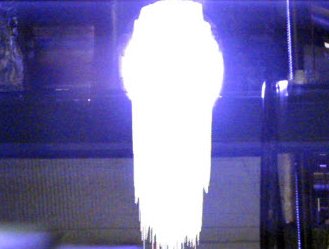
The basis of the fusion idea is in utilising a plasma focus machine as is outlined in information on dense plasma focus. Briefly, this is a pinch-type apparatus which has been around many years giving huge community experience working with its physics. There is even a central site based in Singapore which allows people to calculate results varying many parameters of the apparatus.
Some early variability in outcomes delayed continued enthusiastic development of the technology. Yet a number of versions are used throughout the world to observe plasma properties.
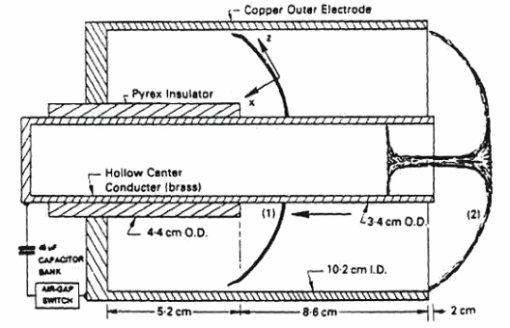
At Lawrenceville Plasma Physics Eric Lerner has managed to reduce a number of the variables in the basic apparatus to enable highly predictable results to be achieved.
In contrast to the larger projects around the world, but similar to the thrust of a number of smaller ones, the fuel for this unit is proposed to be boron (B11) and hydrogen (H1 or a proton - p) through aneutronic fusion. The boron and hydrogen combine to produce a brief intermediate carbon (C12) atom which rapidly decays to three alpha particles or helium (He4) nuclei.
p (1H) + 11B ---> 12C ---> 3α (3 x 4He) + 8.57MeV
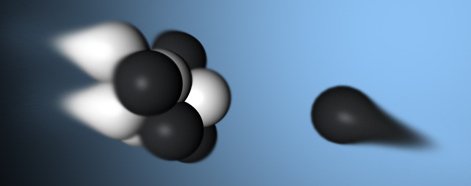
Image Courtesy of Focus Fusion Society
Fuel Consideration
Within the plasma soup a few alpha particles or helium nuclei could fuse with boron nuclei. Such an interaction would be very rare. Some neutron production could occur with this, but at such low energy it would not interact with the surrounding structures to form any long-lived radioactive materials.
Conventional fusion reactions as proposed in the tokamaks, stellarators and the laser inertial confinement systems utilise deuterium and tritium. The advantage of this pathway is that it requires the lowest energies to produce fusion.
The result is a massive production of high energy neutrons which can be usefully employed to produce further tritium fuel by interacting with something like a lithium blanket about the reactor core.
Not all the neutrons are absorbed this way. Others will interact with the surrounding reactor structures forming radioactive by-products in the process. Such products will be shorter life isotopes (around years) than those produced from the traditional nuclear fission process. However they have a significant life to the point that any maintenance on these reactors will need to be done remotely.
The Lawrenceville Plasma Physics Focus Fusion machine can be entered after firing shots to make adjustments and to service it. There is no problem in storing equipment and materials after they have been used in the reactor.
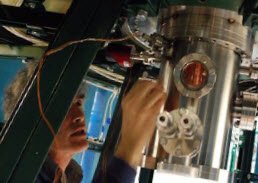
Beneficial By-products
As mentioned in the information on aneutronic-type fusion and dense plasma focus, x-rays are produced as a by-product through bremsstrahlung radiation from electron deflections. These can be controlled by appropriate shielding. They can even be employed in a useful diagnostic way as mentioned in the aneutronic page.
Energy Requirements
Other designs like tokamaks, stellarators and variations struggle to attain the temperatures required for deuterium-tritium fusion.
Around 15keV is the break-even point for deuterium-tritium fusion, with commercial power applications needing to produce a sweet spot for production around four and a half times this, around 66keV, to be worthwhile. Break-even for deuterium-deuterium plasma fusion is around 100keV.
Beyond this level is required for hydrogen and boron fusion, ideally above around 300keV (3.3 billion oK).
Lawrenceville Plasma Physics has achieved electron energies of 400keV in tests in the last year. Ion temperatures are about half that.
Increasing pressure and plasma densities will also improve fusion production. The Lawrenceville Plasma Physics Focus Fusion-1 has been tested to 75 Torr (75mmHg - around one tenth atmospheric pressure).
Tokamaks are usually run at around one thousandth of a Torr.
Confinement Considerations
The pulsed nature of the Focus Fusion design lends itself to achieving these results, similar to inertial confinement ideas and those involving plasma pinches.
To contain an inherently unstable formation like a plasma for long periods as proposed in the magnetic confinement avenues requires huge engineering feats, along with huge costs. Spherical forms of tokamaks and also stellarators are attempting to overcome this challenging limitation. Again they mostly propose to use a deuterium-tritium fuel.
By utilising the inherent instabilities of plasma the Lawrenceville Plasma Physics focus fusion device works with nature's natural tendency rather than against it.
Reactor Design
The Lawrenceville Plasma Physics focus fusion reactor is composed of a capacitor supply which releases a high voltage current into the cathode and anode array - itself around 1 foot (30cm) long and 6-7 inches (15-17.7cm) outer cathode diameter.
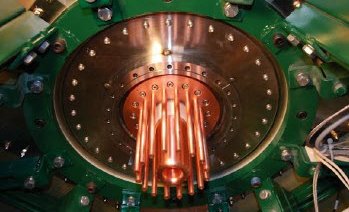
This is constructed to allow an arc to form through the surrounding hydrogen and boron gas. The initial charge creates the plasma (individual ions of positively charged nuclei and negatively charged electrons).
The plasma organises in response to the transmitted current and related magnetic fields to produce filaments which twist in on each other to eventually create a very dense tiny plasmoid. This plasmoid, which increases the magnetic fields the plasma is subjected to, interacts on itself to produce the fusion reaction.
Energy Harvesting
From this are ejected ions (positively charged nuclei) and (negatively charged) electrons in either direction. Alpha particles (helium nuclei) travel in one direction and the electrons in the other - effectively a stream of electricity.
These can be harvested directly in a decelerating coil arrangement reversing the technology of a particle accelerator, or replicating the idea of a transformer. The produced electric current is fed into a storage capacitor bank.
As repeated pulses are created more power can be stored. From this storage energy is available to charge the focus fusion machine. The rest can be fed into the power grid.
Such a system bypasses the way power is generated in nearly all our current major power plants where the heat produced heats water which drives turbines which produce power through alternators or similar devices. Steam generators form a large bulk of conventional energy generation systems. They also account for a large percentage (up to 80%) of the construction cost.
Lawrenceville Plasma Physics Unit Cost
The basic focus fusion unit of Lawrenceville Plasma Physics is extimated to cost around US$300,000 once in production. The fuel to run it will be just over 2kg (5lbs) a year.
Power generated from these plants will be around a fiftieth the cost of conventional power generation. Most alternative energy options involve a higher per kilowatt generation cost than conventional, currently-used ones. Here we have one incredibly cheaper.
Fuel Supply
What of the fuel itself?
Hydrogen is readily available through nature, most conveniently in water. Other nuclear fusion options which propose the use of deuterium are pleased that their basic fuel is available in water at around one molecule in 3200 (by weight)! The basic hydrogen molecule is numerically 6,400 times as common!
Boron exists as boric acid naturally in seawater at 4.5mg/L. Those countries relying on desalination for water supply have to remove boric acid to meet WHO guidelines for drinking water of less than 0.5mg/L. This can be achieved through reverse osmosis.
The largest concentrations of boron (as mineral salts) occur in two major areas, the USA and Turkey. The USA, from the Mojave desert area, supplies the majority of the world's requirements. Turkey's deposits, mainly in the central and western regions, are estimated to hold 75% of the world's supply. It is currently largely untapped.
Two naturally occurring isotopes exist - 11B (Focus Fusion's fuel) and 10B in around an 80:20 proportion.
History So Far
What has been achieved by Lawrenceville Plasma Physics so far?
Eric Lerner has been involved in the technology for many years and has a background in astrophysics from where most of our observations of the nature and forms of plasma come. He has had contact with many other facilities involved in plasma focus ideas. South America has a number of units in existence. He has spent time in Chile with observatories there.
He has presented his ideas for focus fusion at many conferences and forums including at Google as a keynote speaker in its tech talks.
Initial development of the device though Lawrenceville Plasma Physics
in association with the University of Illinois and Texas A&M
University was through NASA funding for alternative propulsion systems
from 1994 to 2001.
After The Cut
When NASA's funding was cut finance was no longer available from this source. Since then Lawrenceville Plasma Physics has relied on private funding which has been in the vicinity of a few million dollars.
So far with this Lawrenceville Plasma Physics has shown its ability to produce reproducable pulses. Design ideas have been adjusted to allow this. One development suggested by research team member Aaron Blake has imparted additional angular momentum to the pulse through an small coil and low currents. This has shown the possibility of doubling fusion output by stabilising the twisting plasma filaments to produce a more effective plasmoid.
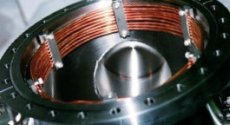 |
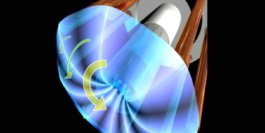 |
As noted before fill pressures have been increased. Fusion production generally increases at the square of the plasma pressure.
Increased levels of current have been able to be applied. As noted also electron temperatures of 400keV have been registered. The keV, although reflecting temperature, is more a reflection of energy imparted to ions and electrons. A charged particle passing through that voltage difference will increase its energy by that amount. Higher energies give higher momentum, increasing the likelihood of fusion interactions.
To this point most of the testing has been done with a basic deuterium fuel.
Better Outputs
When looked at from equivalent amounts of input energy to produce a measured neutron output from fusion Lawrenceville Plasma Physics' results have been four times higher that that of the huge US NIF project. NIF was using the lower temperature requirement deuterium-tritium fuel. If the energy requirements for the different fuels is adjusted for, Lawrenceville Plasma Physics would have produced sixty times the neutron output to NIF's.
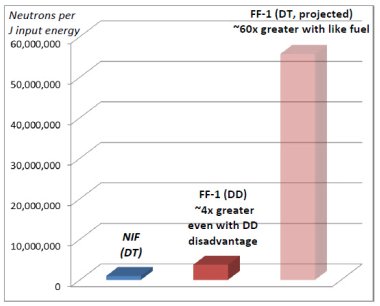
The next step is to test the hydrogen and boron mixture!
Once this viability is established then it is a matter of showing the focus fusion device can reproduce the reaction repeatedly over a multitude of shots to the point it would be a reliable nuclear fusion reactor.
After a pause for eighteen months, in mid year 2015, the company began test firing its new tungsten electrodes. The aim had been to achieve a decrease in released impurities that reduced fusion output.
As their released report showed, there was a ten-fold decrease in these impurities, but not to the extent that was sought. It is expected further firings will show again less impurities.
Beryllium Enters
Beyond this, and in line with the original plans for Lawrenceville Plasma Physics' device, the US Department of Commerce has granted permission for the importation of beryllium cylindrical billets from Kazakhstan. With this expected to occur later in 2015, the projected effective dense focus device could be up and running in 2016. A prototype more in line with the expected commercial version will have been built!
In an update, the new beryllium electrodes have just been delivered as of mid August 2017! Yes, rather a delay, but hopefully these should be installed before the end of 2017.
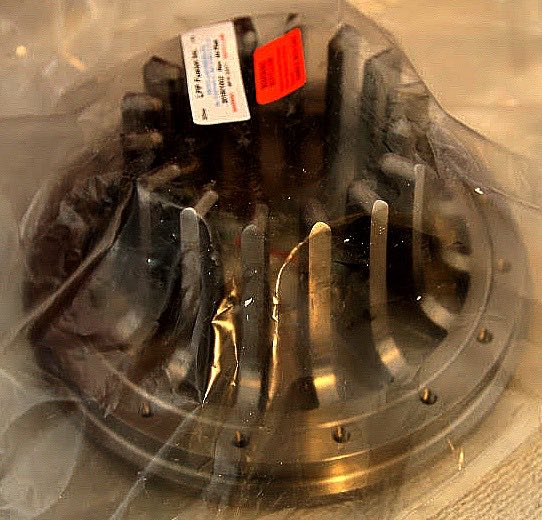 New beryllium electrodes at LPP lab - plastic wrapped to prevent atmospheric moisture corrosion. From communication September 11, 2017.
New beryllium electrodes at LPP lab - plastic wrapped to prevent atmospheric moisture corrosion. From communication September 11, 2017.There had been delays with the titanium intermediate step electrodes showing problems with an oxide build up.
As expected beryllium has showed less problems with this. Yet it has had its own challenges.
There were multiple considerations to adjust including contacts, new camera ports, and seating the equipment effectively.
At last though initial shots have been fired. By analysing results so far further refinements have been made. Soon hydrogen with boron will be in the chamber....
It is expected to be in the second half of 2024! For more on this check the June 2024 report.
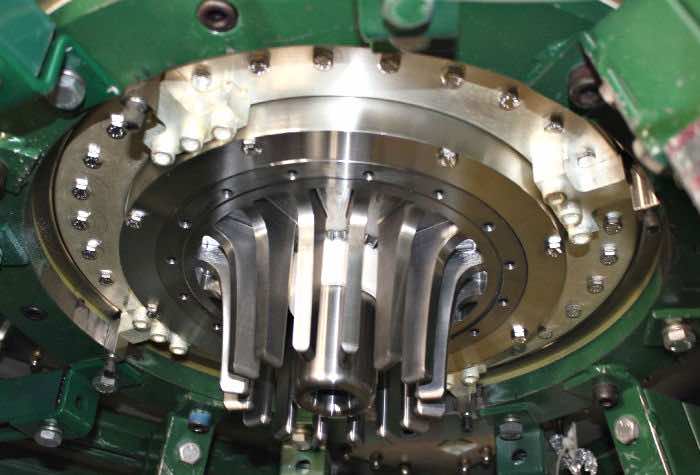 Beryllium electrodes in place
Beryllium electrodes in placeWith its compact size and the safety of such a design, reactors could be established close to population centres, again lowering costs that are associated with power reticulation.
As the reactor units are relatively cheap to produce less well-off countries and communities will be able to afford them.Alternative energy that is available continuously and, due to its modular nature, reliably will be available throughout the world.
To see a summary of available options for alternative energy and how Lawrenceville Plasma Physics with its Focus Fusion-1 device stacks up against alternatives see the e-book I have written.
Lawrenceville Plasma Physics is working on an exciting development that promises to meet so many requirements in our growing world.
New! Comments
Have your say about what you just read! Leave me a comment in the box below.